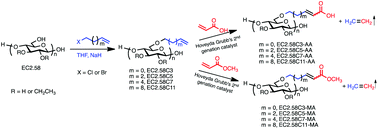Imparting functional variety to cellulose ethers via olefin cross-metathesis†
Abstract
Olefin cross-metathesis is a valuable new approach for imparting functional variety to cellulose ethers. Starting from commercially available ethyl cellulose, terminally unsaturated alkyl groups were appended as metathesis handles by reaction with allyl chloride, 5-bromo-1-pentene, 7-bromo-1-heptene and 11-bromo-1-undecene, employing sodium hydride catalyst. These olefin-terminal ethyl cellulose derivatives were then subjected to olefin cross-metathesis with a variety of electron-poor olefin substrates, including acrylic acid and acrylate esters under optimized conditions (5–10 mol% Hoveyda-Grubbs’ 2nd generation catalyst, 37 °C, 2 h). The effects of varying the length of the ω-unsaturated alkyl handle, and of the solvent systems used were evaluated. Ethyl cellulose containing a pent-4-enyl substituent performed best in cross metathesis reactions and a hept-6-enyl substituent gave similarly good results. Ethyl cellulose with allyl substituents gave low to moderate metathesis conversion (<50%), possibly due to steric effects and the proximity of the ether oxygen to the terminal olefin. Interestingly, longer tethers (undec-10-enyl) gave high conversions (up to 90%) but relatively slow reactions (ca. 12 h needed for high conversion). While limited in this study by the relatively low DS (OH) of the starting commercial ethyl cellulose materials, this methodology has strong promise for introduction of diverse functionality to cellulose ethers in chemospecific and mild fashion, enabling amorphous solid dispersion and other applications.


 Please wait while we load your content...
Please wait while we load your content...